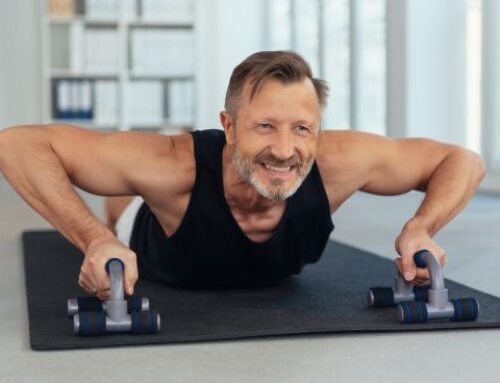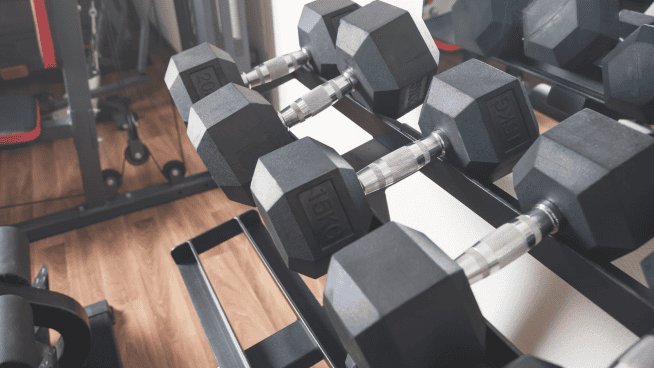What Does It Mean to Be “Fit”?
When working in the strength and conditioning or performance realm of fitness, defined targets and benchmarks are easy to determine – there are certain requirements of the sport and through a proper assessment we can identify the areas that need improvement and from there establish what is required to achieve them. When working in the domain of general health and fitness, however, it can become a little less clear. In fact, when there isn’t a sport or event that someone is specifically training for, one of the most common responses about what they want from the program is to be healthier – increase lean muscle mass, lose body fat – but more often it’s a broader “generally improve overall fitness” statement. The problem is that what is seen as “being fit” is dependent on the individual’s perspective – for some, it’s a particular look rather than any sort of functional skill and for others it’s about being able to complete some sort of life skill with greater ease, like going up a flight of stairs without being winded or being able to play with the grandkids. While all of these are valid goals, they can be difficult to measure quantitatively and therefore challenging to design or select the right program for… so having a more empirical definition of what “fit” and “healthy” looks like can be invaluable in setting truly individual goals and choosing the perfect plan.
Start by Determining How Fitness Is Measured
The best place to begin is by narrowing our definition down to some specific categories, and this is relatively easy to do: to have a wholly inclusive level of fitness you should have:
- Ease of Movement – pain free, with a reasonable range of motion both actively (“mobile”) and passively (“flexible”)
- A reasonable level of strength in all movement types to allow day-to-day activities
- A well-conditioned aerobic system specific to the activities you enjoy
- A body composition that doesn’t present an unnecessary health risk
Utilizing these refined groupings, it becomes easier to measure both where you’re starting as well as where you would need to get to, and thus easier to choose or design a program. So, what would be some reasonable targets within each of these sets?
Ease of Movement
This category would historically have been called “flexibility” – meaning that to consider one’s self “fit”, you would need to be able to hit a certain target in an assessment like the sit-and-reach test. The limitations of this test, and others like it, is that a) the standards being used to determine a “passing” grade are somewhat arbitrary; b) these assessments tend to simplify the findings when, in fact, there are multiple systems that are contributing; and c) they may not be relevant to the individual’s needs. So rather than randomly choosing a measurement that may or may not be relative, instead start by assessing how well you can perform the fundamental movements (squat, hinge, push, pull and dynamic trunk stability) by finding a reputable checklist of benchmarks – or better yet, a qualified coach – and gauging how well you can complete each of them. Pay specific attention to whether any of them cause pain[1], as this automatically means seeking the guidance of a health professional like a physical therapist or doctor.
Strength
How strong is strong enough? While the obvious answer is “it depends on what you need the strength for”, there are some baseline standards that you should be capable of doing. In this case, we’re not looking so much at how much weight you can move, either in an absolute sense (the total amount you’re moving) or a relative sense (the amount of weight compared to what you weigh), as these tend to lean into performance-based metrics. In this scenario for the definition of “functional strength” it’s probably best to consider your relative capabilities in terms of muscular endurance rather than standards based on absolute weight.
Owing to the individualized nature of strength needs, it can be difficult to find consistent standards or norms that are deemed “good”. This can be attributed to a few different things: the personal bias of the person (or persons) designing the test and variations in testing are a couple that come to mind. Whatever the case, you can get a lot of information from “The Big Three” – a squat, a push, and a pull. Narrowing it down to these, examining the norms across a variety of populations and extrapolating from resources available[2][3][4], the following could be used as “healthy” standards for day-to-day living:
Goblet Squat @ 25% BW
Women:
- 19-35 = 20
- 36-50 = 18
- 51-65 = 15
- 66+ = 10
Men:
- 19-35 = 35
- 36-50 = 27
- 51-65 = 20
- 66+ = 15
Push Ups
Women (elevated to approximately 18”)
- 19-35 = 15
- 36-50 = 12
- 51-65 = 10
- 66+ = 5
Men
- 19-35 = 30
- 36-50 = 23
- 51-65 = 16
- 66+ = 10
TRX Row (with feet directly under the anchor point)
Women
- 19-35 = 12
- 36-50 = 10
- 51-65 = 8
- 66+ = 6
Men
- 19-35 = 25
- 36-50 = 20
- 51-65 = 17
- 66+ = 12
Cardiovascular Health
Your cardiovascular health can be more difficult to narrow down to a specific test, since injuries and/or personal preferences mean a wide variety of testing protocols, and therefore difficult to create comparisons. However, since walking or running has the least number of entry barriers (minimal equipment is required and there is little technical skill on the most basic level) there are many walk-run options as long as they’re not contraindicated by injury history. The Cooper Twelve-Minute Walk/Run Test[5] is a long-standing method to evaluate your aerobic health and only requires healthy knees and hips, a pair of runners and a track – then as the name suggests, you set a timer for twelve minutes and see how far you can get in that time.
Women
- 19-35 = 1700m
- 36-50 = 1550m
- 51-65 = 1250m
- 66+ = 1000m
Men
- 19-35 = 2050m
- 36-50 = 1750m
- 51-65 = 1450m
- 66+ = 1150m
Body Composition
Here we find ourselves in something of a controversial quagmire, as the focus on what “fit” should look like is both extremely subjective as well as having the potential to generate unnecessary and unproductive guilt, shame, and anxiety. However, to avoid considering it entirely is to also ignore the fact that body composition does have a significant impact on our health and fitness – more weight naturally means more load on the lower body joints (hips, knees, and ankles) which can lead to a wearing down of these joints and potential lower back issues as a result. Also, an excess of visceral body fat (body fat throughout the organs and concentrated around the trunk or abdomen) is linked to chronic diseases such as coronary heart disease, hypertension, and diabetes.[6] Adding to the complexity surrounding this, there are numerous ways to measure and assess body composition, like the DEXA scan (“dual-energy X-ray absorptiometry”) or the BMI (“body mass index”), all with varying degrees of impediments or value: the DEXA is difficult and expensive to test and the BMI, while valuable from the perspective of analyzing a population fails to take into account the individual (and important) factors like age, sex, ethnicity and muscle mass.
One of the most objective, least intrusive and easy to implement measures of body composition health is the “waist-to-hip” ratio – measuring yourself around the true, or natural waist (under the ribs and on top of the pelvis, not necessarily where your pants sit) and at the widest points of your hips. Once you have these two numbers, divide the waist by the hip to get your ratio[7].
Women
- 19-35 = < 0.72
- 36-50 = < 0.73
- 51-65 = < 0.75
- 66+ = < 0.76
Men
- 19-35 = < 0.87
- 36-50 = < 0.89
- 51-65 = < 0.90
- 66+ = < 0.91
Remember – These Are Signposts with No Context
This is by no means an exhaustive list, nor is it meant to be a singularly defining one – simply some suggested checkpoints or common “road signs” to help narrow down an extremely wide-ranging subject. In fact, it is worthwhile to speak to your physician and see what assessments they would recommend to you based on their knowledge of your personal history, as they will know where to look beyond these broader definitions. What these should allow, however, is for you to get a general sense of your current status and, from an activity and lifestyle perspective, at least give you a direction to get started.
[1] “Pain” is not necessarily “discomfort” or “tightness”. While these need to be noted and considered, “pain” has a bite to it and is a warning sign from your body. Learning to tell the difference is a part of gaining a full understanding of your health and fitness.
[2] https://canadacollege.edu/fitnesscenter/assess-muscle-endurance.php
[3] https://danjohn.net/2013/04/strength-standards-sleepless-in-seattle/
[4] https://www.mayoclinic.org/healthy-lifestyle/fitness/in-depth/fitness/art-20046433
[5] Standards listed here adapted from Cooper, K.H. (1968), “A means of assessing maximal oxygen uptake,” Journal of the American Medical Association, 203:201-204
[6] Harvard T.H. Chan School of Public Health: “Waist Size Matters.”
[7] Adapted from Heyward, VH, Stolarczyk LM: Applied Body Composition Assessment. Champaign, IL, Human Kinetics, 1996, p82.
RECOMMENDED FOR YOU
MOST POPULAR
What Does It Mean to Be “Fit”?
When working in the strength and conditioning or performance realm of fitness, defined targets and benchmarks are easy to determine – there are certain requirements of the sport and through a proper assessment we can identify the areas that need improvement and from there establish what is required to achieve them. When working in the domain of general health and fitness, however, it can become a little less clear. In fact, when there isn’t a sport or event that someone is specifically training for, one of the most common responses about what they want from the program is to be healthier – increase lean muscle mass, lose body fat – but more often it’s a broader “generally improve overall fitness” statement. The problem is that what is seen as “being fit” is dependent on the individual’s perspective – for some, it’s a particular look rather than any sort of functional skill and for others it’s about being able to complete some sort of life skill with greater ease, like going up a flight of stairs without being winded or being able to play with the grandkids. While all of these are valid goals, they can be difficult to measure quantitatively and therefore challenging to design or select the right program for… so having a more empirical definition of what “fit” and “healthy” looks like can be invaluable in setting truly individual goals and choosing the perfect plan.
Start by Determining How Fitness Is Measured
The best place to begin is by narrowing our definition down to some specific categories, and this is relatively easy to do: to have a wholly inclusive level of fitness you should have:
- Ease of Movement – pain free, with a reasonable range of motion both actively (“mobile”) and passively (“flexible”)
- A reasonable level of strength in all movement types to allow day-to-day activities
- A well-conditioned aerobic system specific to the activities you enjoy
- A body composition that doesn’t present an unnecessary health risk
Utilizing these refined groupings, it becomes easier to measure both where you’re starting as well as where you would need to get to, and thus easier to choose or design a program. So, what would be some reasonable targets within each of these sets?
Ease of Movement
This category would historically have been called “flexibility” – meaning that to consider one’s self “fit”, you would need to be able to hit a certain target in an assessment like the sit-and-reach test. The limitations of this test, and others like it, is that a) the standards being used to determine a “passing” grade are somewhat arbitrary; b) these assessments tend to simplify the findings when, in fact, there are multiple systems that are contributing; and c) they may not be relevant to the individual’s needs. So rather than randomly choosing a measurement that may or may not be relative, instead start by assessing how well you can perform the fundamental movements (squat, hinge, push, pull and dynamic trunk stability) by finding a reputable checklist of benchmarks – or better yet, a qualified coach – and gauging how well you can complete each of them. Pay specific attention to whether any of them cause pain[1], as this automatically means seeking the guidance of a health professional like a physical therapist or doctor.
Strength
How strong is strong enough? While the obvious answer is “it depends on what you need the strength for”, there are some baseline standards that you should be capable of doing. In this case, we’re not looking so much at how much weight you can move, either in an absolute sense (the total amount you’re moving) or a relative sense (the amount of weight compared to what you weigh), as these tend to lean into performance-based metrics. In this scenario for the definition of “functional strength” it’s probably best to consider your relative capabilities in terms of muscular endurance rather than standards based on absolute weight.
Owing to the individualized nature of strength needs, it can be difficult to find consistent standards or norms that are deemed “good”. This can be attributed to a few different things: the personal bias of the person (or persons) designing the test and variations in testing are a couple that come to mind. Whatever the case, you can get a lot of information from “The Big Three” – a squat, a push, and a pull. Narrowing it down to these, examining the norms across a variety of populations and extrapolating from resources available[2][3][4], the following could be used as “healthy” standards for day-to-day living:
Goblet Squat @ 25% BW
Women:
- 19-35 = 20
- 36-50 = 18
- 51-65 = 15
- 66+ = 10
Men:
- 19-35 = 35
- 36-50 = 27
- 51-65 = 20
- 66+ = 15
Push Ups
Women (elevated to approximately 18”)
- 19-35 = 15
- 36-50 = 12
- 51-65 = 10
- 66+ = 5
Men
- 19-35 = 30
- 36-50 = 23
- 51-65 = 16
- 66+ = 10
TRX Row (with feet directly under the anchor point)
Women
- 19-35 = 12
- 36-50 = 10
- 51-65 = 8
- 66+ = 6
Men
- 19-35 = 25
- 36-50 = 20
- 51-65 = 17
- 66+ = 12
Cardiovascular Health
Your cardiovascular health can be more difficult to narrow down to a specific test, since injuries and/or personal preferences mean a wide variety of testing protocols, and therefore difficult to create comparisons. However, since walking or running has the least number of entry barriers (minimal equipment is required and there is little technical skill on the most basic level) there are many walk-run options as long as they’re not contraindicated by injury history. The Cooper Twelve-Minute Walk/Run Test[5] is a long-standing method to evaluate your aerobic health and only requires healthy knees and hips, a pair of runners and a track – then as the name suggests, you set a timer for twelve minutes and see how far you can get in that time.
Women
- 19-35 = 1700m
- 36-50 = 1550m
- 51-65 = 1250m
- 66+ = 1000m
Men
- 19-35 = 2050m
- 36-50 = 1750m
- 51-65 = 1450m
- 66+ = 1150m
Body Composition
Here we find ourselves in something of a controversial quagmire, as the focus on what “fit” should look like is both extremely subjective as well as having the potential to generate unnecessary and unproductive guilt, shame, and anxiety. However, to avoid considering it entirely is to also ignore the fact that body composition does have a significant impact on our health and fitness – more weight naturally means more load on the lower body joints (hips, knees, and ankles) which can lead to a wearing down of these joints and potential lower back issues as a result. Also, an excess of visceral body fat (body fat throughout the organs and concentrated around the trunk or abdomen) is linked to chronic diseases such as coronary heart disease, hypertension, and diabetes.[6] Adding to the complexity surrounding this, there are numerous ways to measure and assess body composition, like the DEXA scan (“dual-energy X-ray absorptiometry”) or the BMI (“body mass index”), all with varying degrees of impediments or value: the DEXA is difficult and expensive to test and the BMI, while valuable from the perspective of analyzing a population fails to take into account the individual (and important) factors like age, sex, ethnicity and muscle mass.
One of the most objective, least intrusive and easy to implement measures of body composition health is the “waist-to-hip” ratio – measuring yourself around the true, or natural waist (under the ribs and on top of the pelvis, not necessarily where your pants sit) and at the widest points of your hips. Once you have these two numbers, divide the waist by the hip to get your ratio[7].
Women
- 19-35 = < 0.72
- 36-50 = < 0.73
- 51-65 = < 0.75
- 66+ = < 0.76
Men
- 19-35 = < 0.87
- 36-50 = < 0.89
- 51-65 = < 0.90
- 66+ = < 0.91
Remember – These Are Signposts with No Context
This is by no means an exhaustive list, nor is it meant to be a singularly defining one – simply some suggested checkpoints or common “road signs” to help narrow down an extremely wide-ranging subject. In fact, it is worthwhile to speak to your physician and see what assessments they would recommend to you based on their knowledge of your personal history, as they will know where to look beyond these broader definitions. What these should allow, however, is for you to get a general sense of your current status and, from an activity and lifestyle perspective, at least give you a direction to get started.
[1] “Pain” is not necessarily “discomfort” or “tightness”. While these need to be noted and considered, “pain” has a bite to it and is a warning sign from your body. Learning to tell the difference is a part of gaining a full understanding of your health and fitness.
[2] https://canadacollege.edu/fitnesscenter/assess-muscle-endurance.php
[3] https://danjohn.net/2013/04/strength-standards-sleepless-in-seattle/
[4] https://www.mayoclinic.org/healthy-lifestyle/fitness/in-depth/fitness/art-20046433
[5] Standards listed here adapted from Cooper, K.H. (1968), “A means of assessing maximal oxygen uptake,” Journal of the American Medical Association, 203:201-204
[6] Harvard T.H. Chan School of Public Health: “Waist Size Matters.”
[7] Adapted from Heyward, VH, Stolarczyk LM: Applied Body Composition Assessment. Champaign, IL, Human Kinetics, 1996, p82.










